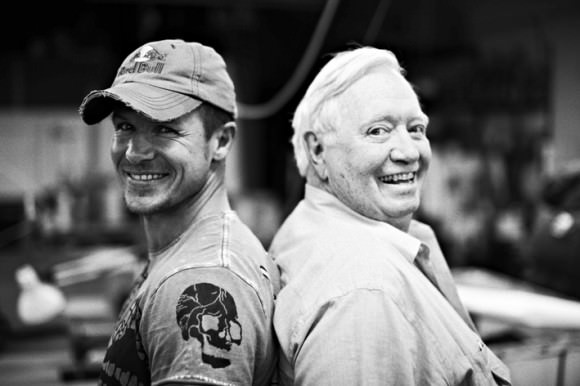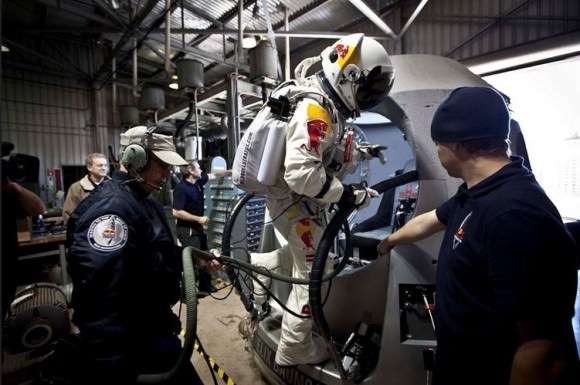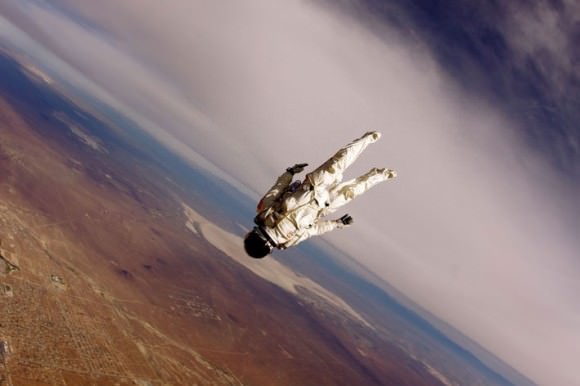In 2010, we reported on Felix Baumgartner and his upcoming attempt to break the sound barrier with his body, in a freefall from the edge of space. Part science experiment, part publicity stunt, part life-long ambition, the Red Bull Stratos mission will have Baumgartner traveling inside a capsule with a stratospheric balloon to 36,500 meters (120,000 feet), where he will step out and attempt a record-setting highest freefall jump ever. The mission was delayed by two years by a lawsuit, but Baumgartner’s jump is now back on, and will be attempted later this year, perhaps late summer or early fall 2012.
If Baumgartner is successful, the mission will break four world records: the altitude record for freefall, the distance record for longest freefall, the speed record for fastest freefall by breaking the speed of sound with the human body, and the altitude record for the highest manned balloon flight.
“This is the biggest goal I can dream of,” Baumgartner said. “If we can prove that you can break the speed of sound and stay alive I think that is a benefit for future space exploration.”
Above is a video of some of the preparations to test Baumgarter’s pressure suit and his body’s reaction to what he will endure during the freefall. The pressurized “space” suit and helmet supplies 20 minutes of oxygen includes especially designed equipment developed to capture data throughout the mission for the medical and scientific advancement of human flight.
The speed of sound — historically called the ‘sound barrier’ – has been broken by rockets, various jet-powered aircraft and rocket-boosted land vehicles. No one has broken it yet with just their body.

Back in 1960, a US Air Force captain named Joe Kittinger made aerospace history by making a jump from 31,000 meters (102,800 feet) in what was called project Excelsior. His jump contributed valuable data that provided ground work for spacesuit technology and knowledge about human physiology for the US space program. There have been several attempts to surpass Kittinger’s record, but none have succeeded, and people have given their lives for the quest.
Kittinger has been working with Baumgartner to help him prepare for the jump.
The Red Bull Stratos mission is named after the energy drink company that is sponsoring the jump by the renowned Austrian skydiver. Red Bull Stratos team members say the mission will explore the limits of the human body in one of the most hostile environments known to humankind, in the attempt to deliver valuable lessons in human endurance and high-altitude technology.
The lawsuit that halted the jump was made by Daniel Hogan, who claimed he pitched the idea of breaking the 50-year old freefall record to Red Bull in 2004, and that Red Bull said they weren’t interested, but later, the company went forward with the idea. Hogan filed a multi-million dollar lawsuit against the energy drink company, but the two parties settled out of court.
The delay may have been a good thing, however. Baumgartner revealed that in December 2010 during first pressure tests of the suit, he had a panic attack, an event which he called “the worst moment of his life.”

“When it came to the crucial pressure test at -60°C, under real conditions with pressure and altitude simulated, and surrounded by cameras, air force personnel and scientists, I realized I just couldn’t do it,” Baumgarter said in an article in the Red Bulletin.
Baumgartner said he thought the suit should feel like ‘second skin’ but instead he felt like his movements and perceptions were restricted. “As soon as the visor closes there’s this nightmarish silence and loneliness – the suit signifies imprisonment. We hadn’t originally conceived of a test that confined me in the suit for five hours – that’s how long the entire mission should take – with the visor closed. After all my past exploits, all the extreme things I’ve done in my career, no one would have ever guessed that simply wearing a space suit would threaten the mission, me included. In the end, the symptoms developed into panic attacks.”

But Baumgarter has been able to over the panic attacks and now is moving forward with the preparations for the jump. The jump will be recorded for a documentary with 15 cameras onboard the capsule and three cameras on Baumgarter’s body. The documentary will be produced by the BBC together with the National Geographic channel, with a feature-length film airing on the two channels following the jump.
The mission will take place in Roswell New Mexico because of the favorable conditions. The area is sparsely populated, plus it has some of the world's best facilities for balloon launches such as this, and the weather allows several good windows for a successful launch.
For more information, see the Red Bull Stratos website, and the Red Bulletin.
Take a look at the infographic about the jump.
Image Credits: Red Bull Stratos. Original Article Written by Nancy Atkinson of Universe Today.
No comments:
Post a Comment